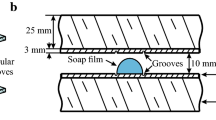Abstract
The evolution of shock-accelerated heavy-gas cylinder surrounded by the air with different Atwood numbers (\(A_t=0.28, 0.50, 0.63\)) is investigated, concentrating on shock focusing and jet formation. Experimentally, a soap film technique is used to generate an ideal two-dimensional discontinuous gas cylinder with a clear surface, which can guarantee the observation of shock wave movements inside the cylinder. Different Atwood numbers are realized by different mixing ratios of \(\hbox {SF}_6\) and air inside the cylinder. A high-speed schlieren system is adopted to capture the shock motions and jet morphology. Numerical simulations are also performed to provide more information. The results indicate that an inward jet is formed for low Atwood numbers, while an outward jet is generated for high Atwood numbers. Different Atwood numbers will lead to the differences in the relative velocities between the incident shock and the refraction shock, which ultimately results in the differences in shock competition near the downstream pole. The morphology and feature of the jet are closely associated with the position and intensity of shock focusing. The pressure and vorticity contours indicate that the jet formation should be attributed to the pressure pulsation caused by shock focusing, and the jet development is ascribed to the vorticity induction. Finally, a time ratio proposed in the previous work for determining the shock-focusing type is verified by experiments.













Similar content being viewed by others
References
Arnett WD, Bahcall JN, Kirshner RP, Woosley SE (1989) Supernova 1987A. Annu Rev Astron Astrophys 27:629–700
Ding JC, Si T, Chen MJ, Zhai ZG, Lu XY, Luo XS (2017) On the interaction of a planar shock with a three-dimensional light gas cylinder. J Fluid Mech 828:289–317
Georgievskii PY, Levin VA (1993) Unsteady interaction of a sphere with atmospheric temperature inhomogeneity at supersonic speed. Fluid Dyn 28(20):568–574
Georgievskii PY, Levin VA, Sutyrin OG (2015) Interaction of a shock with elliptical gas bubbles. Shock Waves 25(20):357–369
Haas JF, Sturtevant B (1987) Interaction of weak shock waves with cylindrical and spherical gas inhomogeneities. J Fluid Mech 181:41–76
Haehn N, Ranjan D, Weber C, Oakley J, Rothamer D, Bonazza R (2012) Reacting shock bubble interaction. Combust Flame 159:1339–1350
Jacobs JW (1992) Shock-induced mixing of a light-gas cylinder. J Fluid Mech 234:629–649
Jacobs JW (1993) The dynamics of shock accelerated light and heavy gas cylinders. Phys Fluids A 5:2239–2247
Jiang GS, Shu CW (1996) Efficient implementation of weighted eno schemes. J Comput Phys 126(1):202–228
Kumar S, Orlicz G, Tomkins C, Goodenough C, Prestridge K, Vorobieff P, Benjamin R (2005) Stretching of material lines in shock-accelerated gaseous flows. Phys Fluids 17:082107
Kumar S, Vorobieff P, Orlicz G, Palekar A, Tomkins C, Goodenough C, Marr-Lyon M, Prestridge K, Benjamin R (2007) Complex flow morphologies in shock-accelerated gaseous flows. Phys D 235:21–28
Layes G, Jourdan G, Houas L (2009) Experimental study on a plane shock wave accelerating a gas bubble. Phys Fluids 21:074102
Lindl JD, McCrory RL, Campbell EM (1992) Progress toward ignition and burn propagation in inertial confinement fusion. Phys Today 45:32–40
Meshkov EE (1969) Instability of the interface of two gases accelerated by a shock wave. Fluid Dyn 4:101–104
Ray J, Samtaney R, Zabusky NJ (2000) Shock interactions with heavy gaseous elliptic cylinders: two leeward-side shock competition modes and a heuristic model for interfacial circulation deposition at early times. Phys Fluids 12:707–716
Richtmyer RD (1960) Taylor instability in shock acceleration of compressible fluids. Commun Pure Appl Math 13:297–319
Samtaney R, Zabusky NJ (1994) Circulation deposition on shock-accelerated planar and curved density-stratified interfaces: models and scalling laws. J Fluid Mech 269:45–78
Tomkins CD, Prestridge K, Rightley P, Vorobieff P, Benjamin R (2002) Flow morphologies of two shock-accelerated unstable gas cylinders. J Vis 5:273–283
Tomkins CD, Prestridge K, Rightley P, Marr-Lyon M, Vorobieff P, Benjamin R (2003) A quantitative study of the interaction of two Richtmyer–Meshkov unstable gas cylinders. Phys Fluids 15:986–1004
Tomkins CD, Kumar S, Orlicz GC, Prestridge KP (2008) An experimental investigation of mixing mechanisms in shock-accelerated flow. J Fluid Mech 611:131–150
Wang M, Si T, Luo X (2013) Generation of polygonal gas interfaces by soap film for Richtmyer–Meshkov instability study. Exp Fluids 54:1427–1435
Wang X, Yang D, Wu J, Luo X (2015) Interaction of a weak shock wave with a discontinuous heavy-gas cylinder. Phys Fluids 27:064104
Yang J, Kubota T, Zukoski EE (1993) Application of shock-induced mixing to supersonic combustion. AIAA J 31:854–862
Zabusky NJ, Zeng SM (1998) Shock cavity implosion morphologies and vortical projectile generation in axisymmetric shock-spherical fast/slow bubble interactions. J Fluid Mech 362:327–346
Zhai Z, Si T, Luo X, Yang J (2011) On the evolution of spherical gas interfaces accelerated by a planar shock wave. Phys Fluids 23:084104
Zhai ZG, Si T, Zou LY, Luo X (2013) Jet formation in shock-heavy gas bubble interaction. Acta Mech Sin 29:24–35
Zou L, Zhai Z, Liu J, Wang Y, Liu C (2015) Energy convergence effect and jet phenomenon of shock-heavy spherical bubble interaction. Sci China-Phys Mech Astron 58:124703
Acknowledgements
This work was supported by the National Natural Science Foundation of China (Nos. 11772329, 11625211, and NSAF U1530103) and the Science Challenge Project (No. TZ2016001).
Author information
Authors and Affiliations
Corresponding author
Rights and permissions
About this article
Cite this article
Ou, J., Ding, J., Luo, X. et al. Effects of Atwood number on shock focusing in shock–cylinder interaction. Exp Fluids 59, 29 (2018). https://doi.org/10.1007/s00348-018-2492-5
Received:
Revised:
Accepted:
Published:
DOI: https://doi.org/10.1007/s00348-018-2492-5




